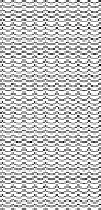Biomedical Engineering Reference
In-Depth Information
5
×
B
1
+
B
2
B
1
+
B
2
bR/Trissl
bR/rehydrated
dry multilayered film
−
Montal film
B
1
B
2
B
1
B
1
B
1
B
1
B
1
B
2
PM multilayer
Teflon
substrate
PM
Aqueous
phase
Teflon
substrate
Aqueous
phase
(A)
(B)
FIGURE 15.8
Working hypothesis for the “Q-tip” experiment. The symbol PM stands for the purple membrane. See text for
further explanation. (From Hong, F. T. (1994). Electrochemical processes in membranes that contain bacteri-
orhodopsin. In: Blank, M., Vodyanoy, I. (Eds.).
Biomembrane Electrochemistry
(Advances in Chemistry Ser. No 235).
Washington, DC: American Chemical Society, pp. 531-560.)
generated by intramolecular charge separation (OD mechanism), contributes one unit of
B
1
in the TM film but five units of
B
1
in the ML film because of the signal additivity. In con-
trast, there is only one unit of
B
2
signal in both types of films because only the top layer
that has access to aqueous protons or other ions can generate
B
2
(ICT mechanism).
As compared with the photoelectric signal from a typical TM film (Figure 15.9A), that
of a freshly prepared ML film (Figure 15.9B) exhibits increased amplitude but diminished
pH sensitivity in accordance with the expected contribution of
B
2
to the overall signal.
Stripping the ML film with a cotton swab reduces the amplitude of the photosignal but
does not completely eliminate it, presumably because the bottom layer adheres tightly to
the Teflon surface (Figure 15.9C). However, the remaining signal shows a pattern of pH
and temperature dependence, which is almost indistinguishable from that of a TM film
(compare Figure 15.9A with 15.9C).
If, however, the ML film is allowed to dry for 4 days or longer, the photosignal from the
ML film, though still enhanced seven to ten times in amplitude, exhibits no trace of pH
dependence (Figure 15.9D). Subsequent stripping reduces the amplitude to sizes compa-
rable to that of a TM film, but the signal does not regain its characteristic pH and temper-
ature dependence (Figure 15.9E). In fact, the diminished signal, after normalization,
superimposes with the corresponding signal before stripping (Figure 15.9F). This obser-
vation is consistent with the complete elimination of the
B
2
component and the persistence
of a pure component,
B
1
. Apparently, prolonged drying has permanently damaged the
B
2
generating mechanism but it has left the
B
1
generating mechanism intact. This interpreta-
tion is also consistent with the assignment of the OD mechanism to
B
1
and the ICT mech-
anism to
B
2
(Section 15.4.1).
Can the
B
2
component be eliminated by other means? Lowering the temperature to 0ºC
reversibly but incompletely suppresses
B
2
. We have also attempted to suppress the
B
2
com-
ponent by means of chemical modification [62]. We found that prior treatment of the pur-
ple membrane with fluorescamine partially (and irreversibly) inhibits
B
2
. However, such a
treatment has no effect on
B
1
. We also found that
B
2
is naturally absent (at pH > 3) in a
mutant D212N but is present at low pH (<2) with a reversed polarity, that is,
B
2
at low pH
has the same polarity as
B
1
[63]. This latter finding suggests that it may be possible to
titrate the pH so that
B
2
becomes completely suppressed in the wild-type bR TM film [64]
(Figure 15.10). The end point of pH titration is the point where
B
2
reverses its polarity.
Figure 15.10A shows the monotonic and continuous variation of the time course of the









